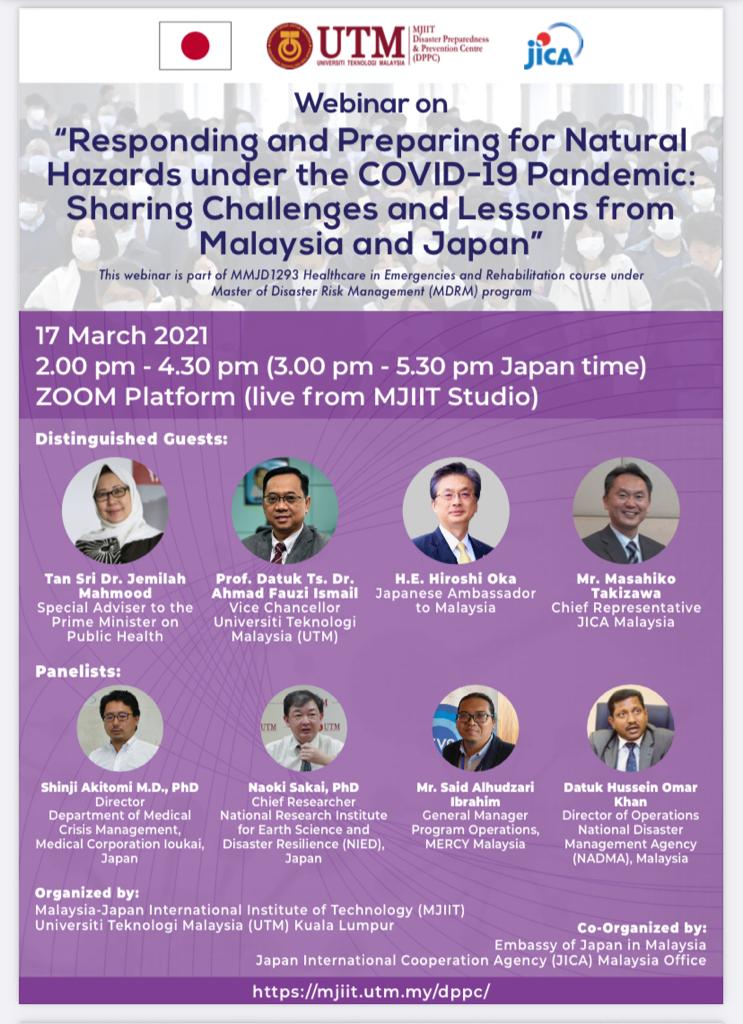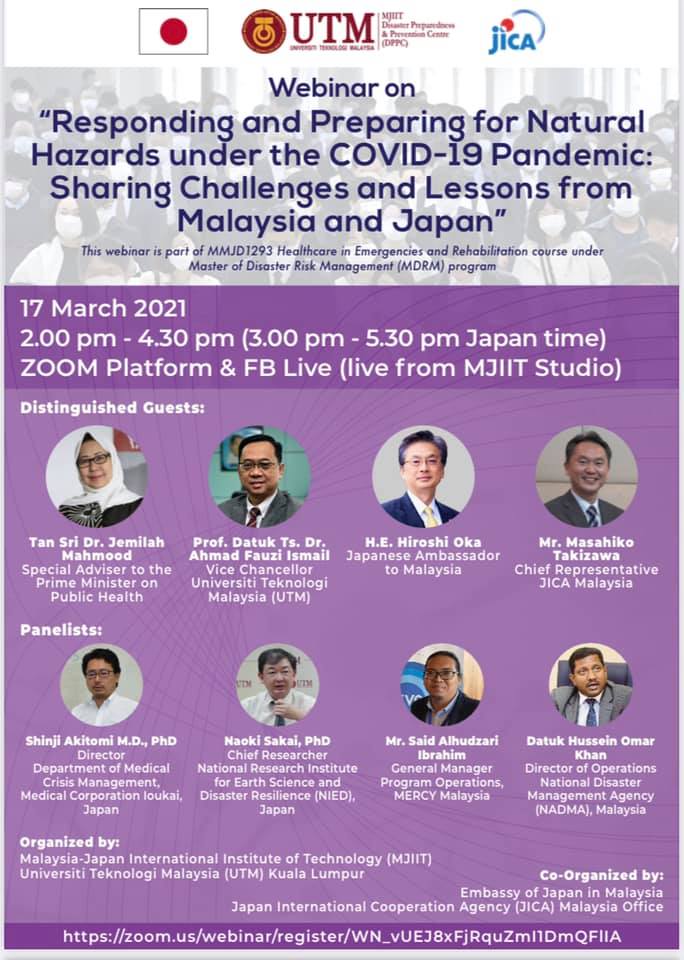
Kuala Lumpur- The Malaysia Japan International Institute of Technology (MJIIT) of Universiti Teknologi Malaysia (UTM) Kuala Lumpur alongside the Embassy of Japan in Malaysia and Japan International Cooperation Agency (JICA) Malaysia had organised a webinar entitled, “RESPONDING AND PREPARING FOR NATURAL HAZARDS UNDER THE COVID-19 PANDEMIC: Sharing Challenges and Lessons from Malaysia and Japan.” through live stream on Zoom platform and Disaster Preparedness and Prevention Center (DPPC) Facebook Live on March 17, 2021 .
This webinar provided a co-learning opportunity and aimed to share the challenges and lesson from Malaysia and Japan in responding to multiple disasters, such as floods and landslides under the COVID-19 pandemic and suggested the way forward to better reduce and prevent such compound disasters in the future.
During the monsoon/typhoon season in 2020 and beginning of 2021, both Malaysia and Japan experienced heavy flooding caused by record-breaking rainfalls that forced tens of thousands of people to be displaced across wide areas. The ongoing COVID-19 pandemic has additionally posed significant challenges for disaster response and called for “new norms” to be quickly established for better disaster risk reduction and management.
In this light, this webinar invited 4 expert speakers to offer different insights on this topic, namely, Dr. Shinji Akitomi, Emergency Physician from Medical Corporation Ioukai and Mr. Naoki Sakai, PhD, Chief Researcher, National Research Institute for Earth Science and Disaster Resilience (NIED), both from Japan, and Mr. Said Alhudzari Ibrahim, General Manager, Program Operations, MERCY Malaysia, and Datuk Hussein Omar Khan, Director of Operations, National Disaster Management Agency (NADMA), Malaysia.
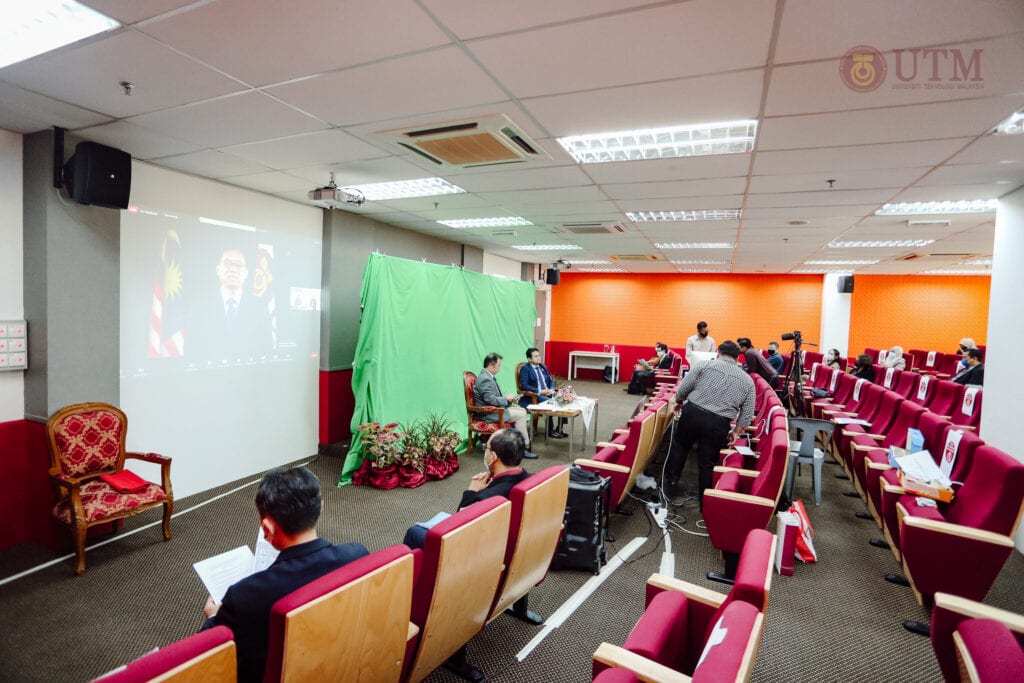
The webinar was officiated by Prof. Datuk Ts. Dr. Ahmad Fauzi Ismail, Vice Chancellor, UTM and Japanese Ambassador to Malaysia, Hiroshi Oka.
Prof. Datuk Ts. Dr. Ahmad Fauzi Ismail pointed out that Universiti Teknologi Malaysia Community responded to COVID-19 threats through R&D and researchers from Universiti Teknologi Malaysia (UTM) have swung into action to respond to the threat posed by COVID-19 pandemic. UTM had taken the initiative in working with the University of Technology Delft from Netherlands and the Ministry of Environment Malaysia in research to improve scientific ways to curb the spread of the COVID-19 virus that could spread through the sewerage system.
“I would like to congratulate the Disaster Preparedness and Prevention Centre (DPPC) of Malaysia-Japan International Institute of Technology (MJIIT), Universiti Teknologi Malaysia (UTM), on its successful track records in disaster risk reduction and prevention efforts both virtually and physically. Although not directly related to the COVID-19 Pandemic, DPPC is trying its best to fulfil the Sendai Pledge in mitigating the Disaster Risk through Research, providing quality education and involving with the community directly to create awareness among the people from the disaster-prone areas,” he added.
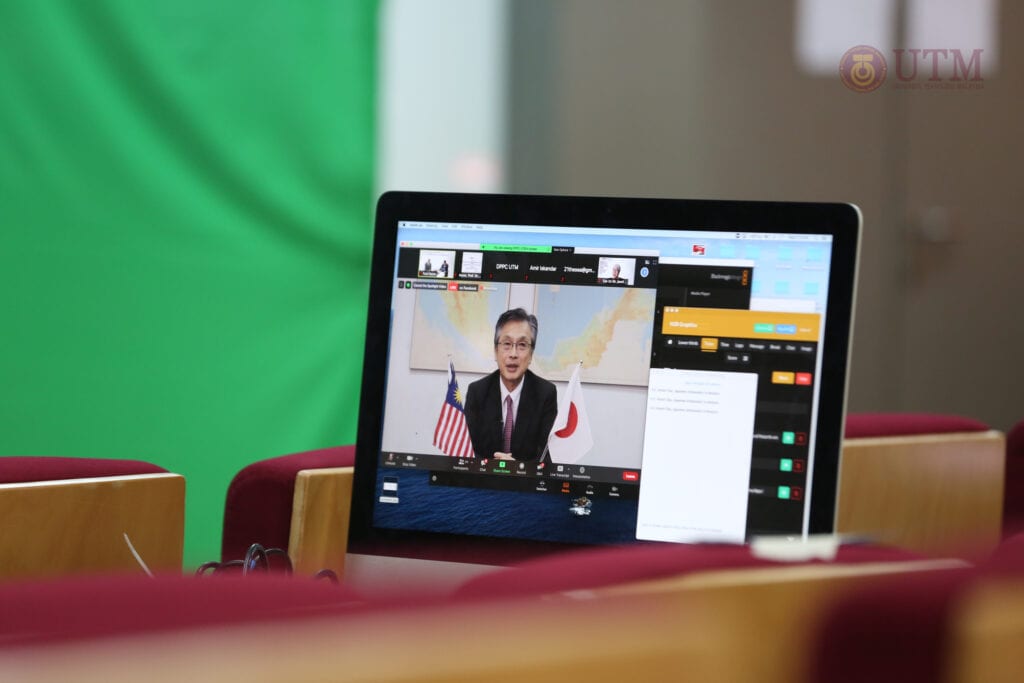
Hiroshi Oka highlighted that this webinar will enable Japan and Malaysia to share each other’s experiences, knowledge and lessons learnt from the pandemic, as well as helping us to overcome challenges, adapt to ‘the new normal’ and hopefully to recover from the damage caused by COVID-19. The seminar addressed the challenges posed by COVID-19 from the perspective of disaster management, which is one of MJIIT’s key focus areas.
“Japan is prone to many types of natural disasters and therefore disaster risk management is one of MJIIT’s educational focus. For instance, MJIIT offers the Master course for Disaster Risk Management to develop future leaders in the fields of disaster management. In fact, some of the graduates from this master course have spearheaded the efforts of the government to formulate SOPs to prevent the spread of Covid-19 and to set up quarantine stations for the country.”
“Within MJIIT, the Disaster Preparedness and Prevention Centre (DPPC) was established to serve as a platform to build networks of organisations and professionals in the field of disaster risk management. The centre also provides scientific basis to plan and implement disaster risk management and reduction measures.” he added.
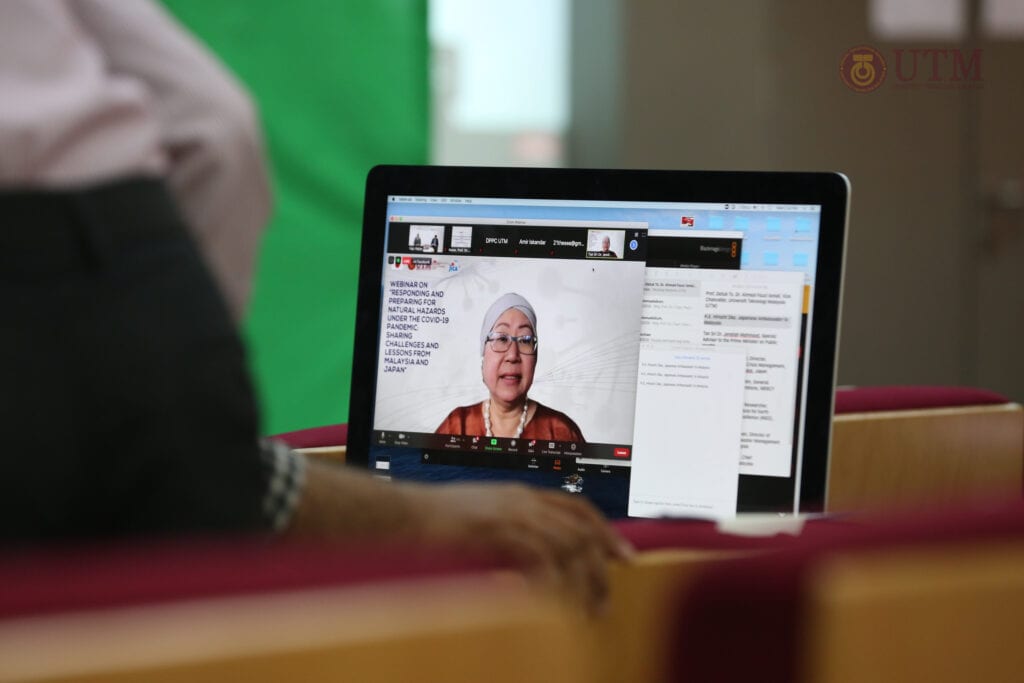
The keynote speech was given by Tan Sri Dr. Jemilah Mahmood, Special Adviser to the Prime Minister of Malaysia on Public Health. Tan Sri Dr Jemilah Mahmood mentioned that it is time for ASEAN to support Japan in the set-up of the centre to benefit the people and economies of the 10 member countries.
“Our region should have its own so-called centre for disease control and prevention…thus this is the opportunity since Japan has funded the establishment of this kind of centre.”
“But this requires all governments in the region to then invest in the centre, because we will then not be facing issues, including like how do we manufacture vaccine, why aren’t we are the one innovating to find the science and technology behind vaccine production, producing kits, detection of cases, and so on,” she said.
She said the establishment of such a centre was extremely important as ASEAN is one of the most impacted regions, continued to be confronted by threats of new and re-emerging infectious diseases, as well as disaster.
“Asia Pacific is the most disaster-affected region in the world; similarly Asia has also been one of the areas that is badly hit by pandemic as well, in the past and currently,” she said.
Meanwhile, she applauded Japan as a respected country in managing disaster preparedness and disaster risk reduction, in terms of policy level and investment in the matter.
Dr. Jemilah added that the pandemic had been a “reality check” for Malaysians to really step up in all the areas, especially in terms of cleanliness and hygiene. She said as a result, a very drastic fall in the incidence of flu and other communicable diseases had been seen in the country because Malaysians have taken a very good public health measure and adhered to the standard operating procedure (SOP) during the pandemic.
Dr. Jemilah ended her speech with five thoughts that we should all consider as we look at where the intersections between disaster management and disaster preparedness or DRR and pandemic preparedness:
- Multi agency efforts are critical.
- Find the balance between centralized and local approaches, whether it is a disaster preparedness and risk reduction approach. Managing a pandemic requires both a central driving policy agenda, but also in local action. Majority of the success will come when people take public health measures and behave in a way that do not allow the virus to transmit. How do we then make sure the links between central and local government is well founded in collaboration?
- Flexible and agile arrangements are required to help governments respond effectively and quickly to different emergencies. Within institutional structures, such measures can be put in place before a crisis occurs. Map out existing staff capacities, such as number of staff areas of expertise and how effectively they can respond to crises. Review the mandates of key departments. Update their responsibilities. Identify how different ministries can actually work together in different types of crisis. Identify how to balance different legislations. Conduct an analysis of how government can optimise their current arrangements and structures. Identify systems or areas that need to be strengthened.
- Data and technology are crucial in supporting an effective crisis response. We have seen the public rising to this with movements like #KitaJagaKita. How do we harness this and make sure that we use this opportunity of the pandemic to really drive the fact that we can only be stronger if we work together? So, how do we then protect data, especially now with everything being driven to a digital agenda? How do we also look beyond that in terms of data protection? What kind of technologies are there and how do we safeguard privacy without violating human rights? Where are the balances and where are the compromises?
- Public trust is key to safeguarding people during any form of crisis. Openness in sharing data and transparently communicating to the public using very clear and evidence-based messages can really help all stakeholders build and sustain trust. Many people think or have a perception that Japan is so successful in its disaster preparedness and management because they have lots of money. Yes they do, but it is also beyond that. It is the attitude of the people of Japan, public health practices, an education system that has built in knowledge, preparedness and an understanding by children and supported by their teachers and every individual alike.

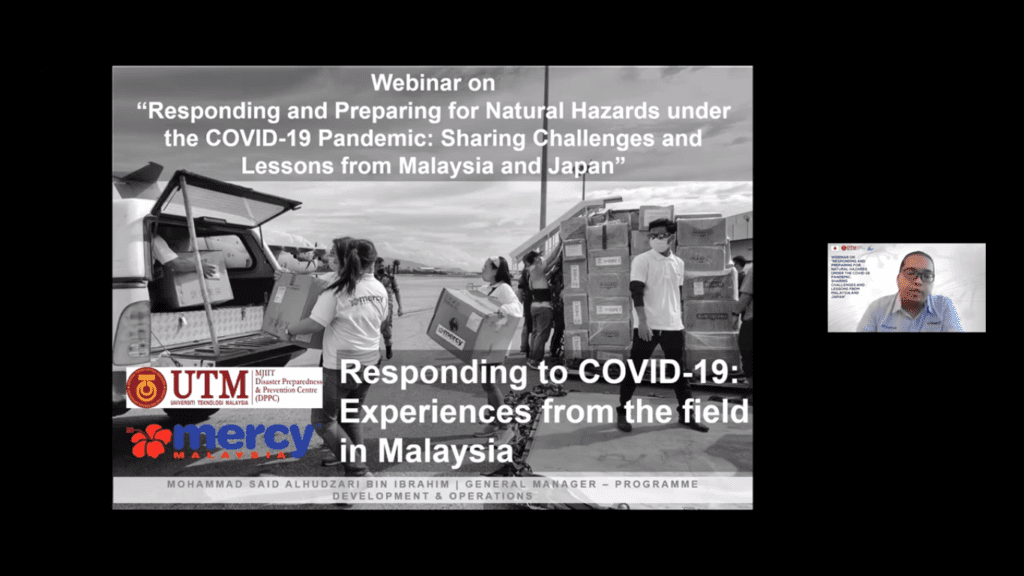
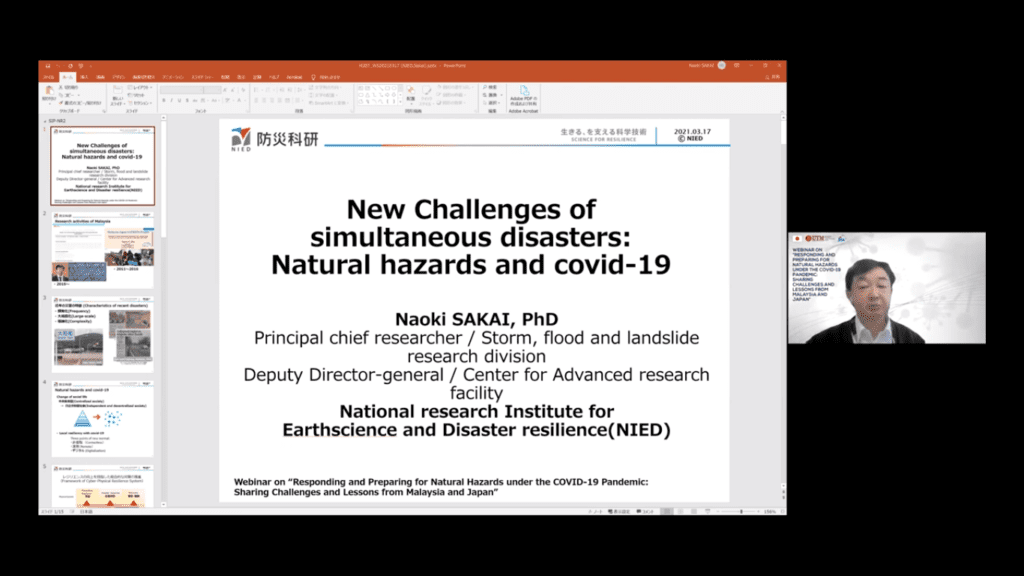

The expert talk session began with a brief sharing on Challenges and Lessons from Malaysia and Japan by Shinji Akitomi, M.D., PhD, Director of Department of Medical Crisis Management, Japan Medical Association Research Institute. He highlighted the issues and implementable measures to COVID-19 from a crisis management perspective as follows; Nature of COVID-19 and the situation in Japan, 22 essentials required for taking measures to COVID-19, various situations encompassing the medical field, and conditions needed to tackle emergency situations.
Mr. Mohammad Said Alhudzari Ibrahim, General Manager – Programme Development and Operations, MERCY Malaysia shared how MERCY responds to COVID-19: Experiences from the field in Malaysia. MERCY Malaysia is known as an international non-profit organization focused on providing medical relief, sustainable health-related development, and risk reduction activities for vulnerable communities, in both crisis and non-crisis situations. He has spoken on Managing Response During Pandemic, Localisation of Response Activities, Opportunities During Pandemic, Guidelines for Evacuation Centre Management, and Challenges in Responding During Pandemic.
Naoki SAKAI, PhD,Chief Researcher, National Research Institute forEarth Science and Disaster resilience (NIED), Japan as one of the respective speakers, elucidated on New Challenges of Simultaneous Disasters: Natural Hazards and COVID-19, upon which he presented the Framework of Cyber-Physical Resilience System and Resilience Model between Science and Society. Evacuation and sheltering of The Basic Disaster Management Plan, Innovation with Large-scale rainfall simulator
Dato’ Hussein Omar Khan , Director of Operations, National Disaster Management Agency (NADMA) covers on Coordinating Compound Disasters: Flood Disaster Response Under COVID-19. He explained that NADMA has developed a special SOP for Disaster Management during Covid-19, as a guidance to responder team as well as evacuation centres in order to prevent the spreading of the pandemic during disaster, especially flood.
“No COVID-19 cases have been detected at flood evacuation centres nationwide, shows that the SOP was adhered to at the evacuation centres by evacuees and related agencies. Effective and successful reduction and management of compound disaster risk critically depending our understanding of the connection and mechanism of the hazards,” he added.
The closing speech was then given by Mr. Masahiko Takizawa, Chief Representative of JICA Malaysia Office, highlighting on how Japan and Malaysia have worked together to cope with COVID-19.
The organizer would like to take this opportunity to thank all of the participants for their participation in making the event successful!
For more information, contact DPPC MJIIT, UTM KL at dppc@utm.my or 03-2203-1585. Follow us on Instagram, Facebook, Twitter, and LinkedIn to keep updated on what’s new @ DPPCUTM.

